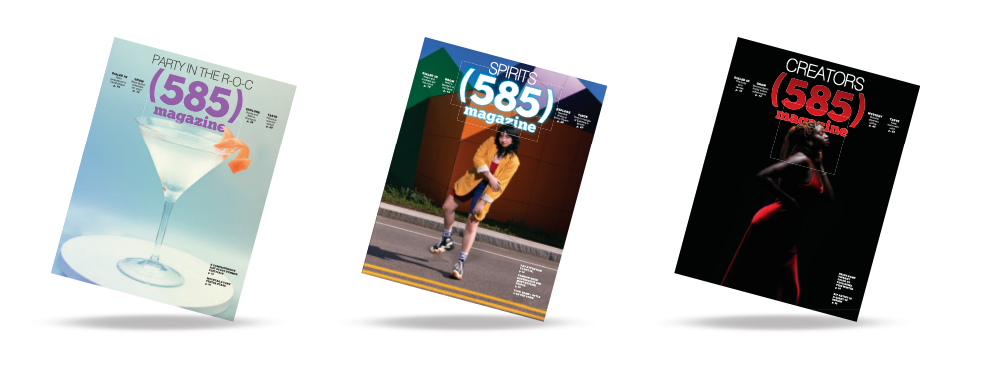Take a hike in the woods or along a secluded path and you might come across a clever fairy-house creation, crafted from items found in nature.
Author and illustrator Tracy Kane’s award-winning Fairy House Series of books has popularized the building of fairy houses across the United States and around the world. An advocate for getting children outside and into nature, Kane has shared the magic of tiny house building for more than 15 years through her books, workshops, and videos.
Kane, a Rochester native and Pittsford-Sutherland alumna, first encountered fairy houses in the late 1990s on Monhegan Island off the coast of Maine. The island has a “magical” forest called Cathedral Woods that is littered with fairy structures. “I saw a little girl working on her fairy house and so I started to create one myself,” said Kane, who wrote her first book in 2000. “Then 9/11 happened and there was a need for people to get outside and do things with their families.” So began the Fairy House Series of books.

Photo provided
Cone shaped Fairy House
Natural materials make the most magical Fairy Houses and build a child’s creativity.
In each of her illustrated storybooks, Kane combines her love of nature with a touch of fairy magic. Her stories emphasize a respect for nature and provide a way for children to learn about and become part of the natural world around them. The first people to buy books and get into fairy-house construction? Grandparents.
“They want something to do with their grandchildren that doesn’t involve video games or electronics,” Kane said. “More importantly, they want to create memories with their grandchildren.” For the most part, everything visible on the fairy house must be natural. Inspired by Kane, websites like Pinterest, Etsy, and Inhabitat are full of kits and ideas to make the perfect home for neighborhood fairies and woodland creatures. She noted her Fairy House Series of books inspires kids to make one in their own backyard.
This summer on July 8 and 9, the Corn Hill Arts Festival will celebrate its fifth year of presenting the Fairy House Tour, based on Kane’s books. Dozens of fairy houses made by local organizations and families are publicly displayed free of charge and prizes are awarded for Best Use of Natural Material, Most Unique, and Most Whimsical, plus a People’s Choice Award.
Last summer 7,000 people toured the display of more than 50 miniature houses. The 10 winning creations (three in each category plus People’s Choice) will then be displayed throughout July at the Strong National Museum of Play.
The Corn Hill Arts Festival is one of many Fairy House Tours held around the country. Featuring more than 200 fairy houses, the Portsmouth Fairy House Tour in New Hampshire is the world’s largest and has raised more than $200,000 for local charities over the past 10 years. Fairy House Tours also take place in Vermont, Connecticut, North Carolina, and Georgia. Kane’s Fairy House Series of books also has spawned a ballet and a musical.
Creating a fairy house is an ideal rainy-day activity for kids and adults. It involves planning, sensibly sourcing materials, problem solving, concentration, and lots of creativity.
Kane worked for many years at WXXI and New Hampshire Public TV as a graphic designer. She now divides her time between Maine (where fairy-house building first started) and North Carolina. So what’s it like to have the Fairy House Tour in her hometown?
“Rochester creates just the most amazing houses,” she said. “The Fairy House Tour took off faster here than any other place.”
Learn more about Kane and her creations at fairyhouses.com.
Building your own fairy house
- Fairy houses come in all shapes and sizes. Be creative. Plan carefully and put a bit of “you” in it.
- Location, location, location. Fairies don’t like to be bothered, so build your fairy house in a quiet place away from roads or busy pathways.
- Fairies are ecologically responsible. They only like natural materials to build and furnish their houses. Use things like sticks, bark, nuts, rocks, pebbles, pinecones and moss. (Remember: fairies also don’t like to harm anything that’s growing, so don’t pick flowers or other living things to furnish your house.)
- Wood fairies and beach fairies like different things. Use materials found in the area where you are planning on building your fairy house.
The Burdick family collects pieces all year long for their whimsical fairy houses
Claire Burdick and her family have been taking part in the Fairy House Tour since 2015. They collect treasures from woods, trails, and parks at different times of the year, and fairy-house construction takes up the dining room table for the better part of two weeks before the Corn Hill Fairy House Tour.
It’s a collaborative family effort with mom, dad, and their two children each adding bits and pieces to the structure. “We create a basic structure and then add everything on top of that,” Claire said. “My husband will come home from work and say, ‘What about this?’ or ‘What about that?’ The kids will have their own suggestions, too.”
For their 2015 fairy house, they knew that they wanted to build a structure with a pedestal. It was a true team effort. Grandparents in another part of the state offered up a tree branch for their perfect fairy house.
Last year’s entry was a cave-like structure. Their entries for both 2015 and 2016 have been awarded “Most Whimsical” and went on to be displayed in the Strong National Museum of Play. “My son was so excited when our house was displayed in The Strong,” Claire said. “He thought we were famous.”
Views: 0




